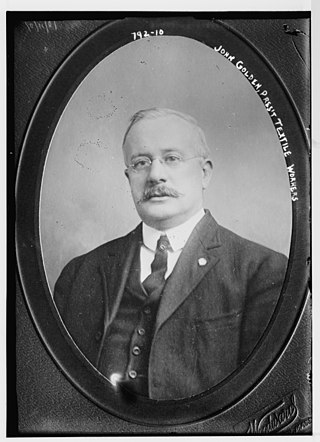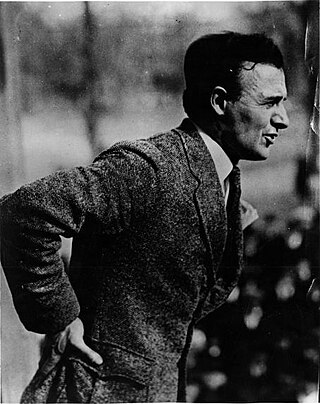
West Warwick is a town in Kent County, Rhode Island, United States. The population was 31,012 at the 2020 census.
The US Textile Workers' Strike of 1934, colloquially known later as The Uprising of '34 was the largest textile strike in the labor history of the United States at the time, involving 400,000 textile workers from New England, the Mid-Atlantic states and the U.S. Southern states, lasting twenty-two days.

The Lawrence Textile Strike, also known as the Bread and Roses Strike, was a strike of immigrant workers in Lawrence, Massachusetts, in 1912 led by the Industrial Workers of the World (IWW). Prompted by a two-hour pay cut corresponding to a new law shortening the workweek for women, the strike spread rapidly through the town, growing to more than twenty thousand workers and involving nearly every mill in Lawrence. On January 1, 1912, the Massachusetts government enforced a law that cut mill workers' hours in a single work week from 56 hours, to 54 hours. Ten days later, they found out that pay had been reduced along with the cut in hours.

The Textile Workers Union of America (TWUA) was an industrial union of textile workers established through the Congress of Industrial Organizations in 1939 and merged with the Amalgamated Clothing Workers of America to become the Amalgamated Clothing and Textile Workers Union (ACTWU) in 1976. It waged a decades-long campaign to organize J.P. Stevens and other Southern textile manufacturers that achieved some successes.

Gill Stadium is a sporting stadium located in Manchester, New Hampshire. It is one of the oldest concrete-and-steel ballparks in the United States. The venue, which mainly hosts amateur baseball and football contests, has a capacity of 3,012.

Joseph James "Smiling Joe" Ettor (1885–1948) was an Italian-American trade union organizer who, in the middle-1910s, was one of the leading public faces of the Industrial Workers of the World. Ettor is best remembered as a defendant in a controversial trial related to a killing in the seminal Lawrence Textile Strike of 1912, in which he was acquitted of charges of having been an accessory.

The Pawtuxet River, also known as the Pawtuxet River Main Stem and the Lower Pawtuxet, is a river in the U.S. state of Rhode Island. It flows 12.3 miles (19.8 km) and empties into the upper Narragansett Bay of the Atlantic Ocean. Together with its two main tributary branches, the North Branch Pawtuxet River and the South Branch Pawtuxet River, it drains a watershed of 231.6 square miles (600 km2), all of which is in the state of R.I.

The 1913 Paterson silk strike was a work stoppage involving silk mill workers in Paterson, New Jersey. The strike involved demands for establishment of an eight-hour day and improved working conditions. The strike began in February 1913, and ended five months later, on July 28. During the course of the strike, approximately 1,850 strikers were arrested, including Industrial Workers of the World (IWW) leaders Bill Haywood and Elizabeth Gurley Flynn.

The Amoskeag Manufacturing Company was a textile manufacturer which founded Manchester, New Hampshire, United States. From modest beginnings it grew throughout the 19th century into the largest cotton textile plant in the world. At its peak, Amoskeag had 17,000 employees and around 30 buildings.

Emil Rieve was an American labor leader. He was president of the Textile Workers Union of America (TWUA) from 1939 to 1956, a vice president of the Congress of Industrial Organizations (CIO) from 1939 to 1955, and a vice president of the AFL-CIO from 1955 to 1960.

Pontiac Mills is a historic textile mill complex on Knight Street in the village of Pontiac, Rhode Island within the city of Warwick. The mills produced the original Fruit of the Loom brand of cloth.

The Valley Queen Mill is an historic mill at 200 Providence Street in West Warwick, Rhode Island.
The United Textile Workers of America (UTW) was a North American trade union established in 1901.

Anne Burlak Timpson was an early twentieth-century leader in labor organizing and leftist political movements. A member of the National Textile Workers Union and Communist Party, Burlak was jailed numerous times for sedition. Based in New England for much of her adult life, Burlak was a candidate for local and state offices in Rhode Island and played a major role in crafting the National Recovery Administration's workplace standards for textile unions during the New Deal era.

The 1907 Skowhegan textile strike was a labor dispute between approximately 225 mill workers and the owners of the Marston Worsted Mill in Skowhegan, Maine, United States. Declared following the firing of 17 year-old French Canadian-American girl named Mamie Bilodeau, the strike was the first successful strike involving the recently formed Industrial Workers of the World.

John Golden was an American textile worker and trade union leader. He was elected president of the United Textile Workers of America (UTW) each year from 1902 until shortly before his death in 1921. At the time of his death, he was declared as important to textile unionism as John Mitchell was to mining unionism.
The 1914–1915 Fulton Bag and Cotton Mills strike was a labor strike involving several hundred textile workers from the Fulton Bag and Cotton Mills in Atlanta, Georgia, United States. The strike, which involved about 500 millworkers, began on May 20, 1914, and ended almost a year later on May 15, 1915, in failure for the strikers.

The 1912–1913 Little Falls textile strike was a labor strike involving workers at two textile mills in Little Falls, New York, United States. The strike began on October 9, 1912, as a spontaneous walkout of primarily immigrant mill workers at the Phoenix Knitting Mill following a reduction in pay, followed the next week by workers at the Gilbert Knitting Mill for the same reason. The strike, which grew to several hundred participants under the leadership of the Industrial Workers of the World (IWW), lasted until January the following year, when the mills and the strikers came to an agreement that brought the workers back to the mills on January 6.

The 1913 Ipswich Mills strike was a labor strike involving textile workers in Ipswich, Massachusetts, United States. The strike began on April 22 and ended in defeat for the strikers by the end of July.

Ben Legere was a union organizer for the IWW and OBU within New England & Canada during their life.
























